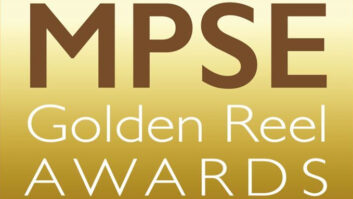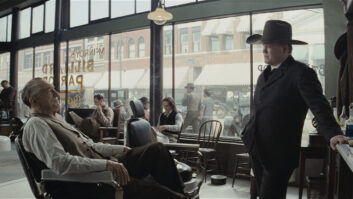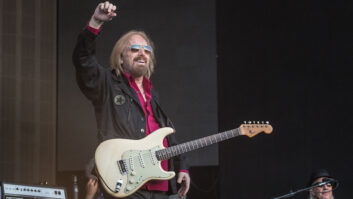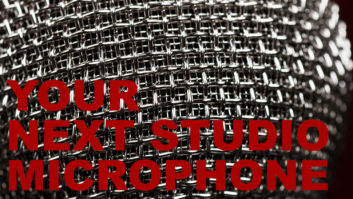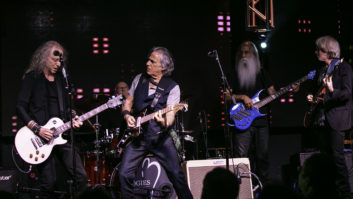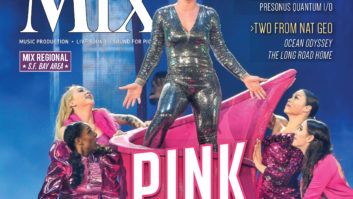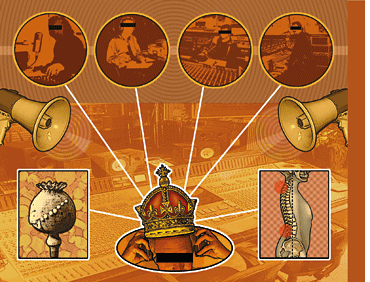

Between them, these four engineering giants — all familiar to regular Mix readers — have more than 500 years of studio experience. Okay, that’s an exaggeration, but they’ve all been around for a while, done great work with top artists on legendary albums and they continue to be vital studio pros.
Illustration: Tad Majewski
When we spoke in mid-March, Tom Flye was working on a pair of DVDs with former Grateful Dead drummer Mickey Hart; Al Schmitt was finishing up a tribute album to Ella Fitzgerald featuring Diana Krall, Natalie Cole, Michael Bublé and others; Ed Cherney had just completed mixes on yet another multiple DVD set from the Rolling Stones called The Biggest Bang; and Elliot Scheiner had been involved in his usual slew of recording and mixing projects for DVD and CD for the likes of Jerry Lee Lewis, the Doobie Brothers and more. In individual interviews, we asked this impressive foursome to comment on some of the concerns of this special issue of Mix.
THE YOUNG AND THE SLEEPLESS
Flye: I’ve done some really long sessions. I remember Rick James said to me one day, “What’s the longest session you ever did with Sly?” I said, “Jeez. I don’t know. Maybe 30 hours?” And he said, “I gotta beat that!” And he did, by quite a bit. I guess I dug my own grave with that one. I also remember the night Rick said, “You know, I’ve been wasting all this time going up to the house getting in bed and then coming back down to the studio later. Tonight, I’m not going to the bed, the bed’s coming to me.” So he sent the bodyguards up to the house and brought the bed down to the studio. That kind of thing doesn’t happen anymore, but I still work some long hours. I had a late one with Mickey [Hart] just last night.

Al Schmitt
Schmitt: I can remember 72-hour days. We’d be in the studio for three days in a row. I remember doing that with Jefferson Airplane. I did another one, believe it or not, on a tribute to [Broadway composers] Lerner and Lowe. But we were on a major deadline to get that out, so we would take an hour or two and sleep on the couch, then get up and keep doing it. But I was in my 20s and it was a lot easier. We didn’t think that much about it; we just thought, “That’s the way it is. It’s the music business.”
Barbra Streisand was one of those artists who didn’t seem to have any idea of time. One night I was heading out the door at 11 o’clock at night after a long day. I had called my wife and told her I was on my way home. And Streisand says, “Al, can we do a good rough mix?” I said, “Sure.” I took my jacket off and sat down and then I didn’t walk out of there until 4 o’clock in the morning. My wife thought I was dead. She was calling the police. And that wasn’t that unusual. A lot of artists think you’re a slave to them and that you will do everything at their beck and call. I don’t do that anymore.
Scheiner: I remember in my first year at A&R [Studios in New York City], maybe 1968, I came in on a Tuesday morning to do a session for a movie called You’re a Big Boy Now, which had music by the Lovin’ Spoonful, and we didn’t finish up until sometime very early morning Friday. I never left. We worked for 70-odd hours. Obviously, it was an extreme deadline.
The other side of that, though, is that sometimes you’d be in the studio endlessly and nothing would be happening at all. There are a bunch of bands in the late ’60s, early ’70s that would book the studio on a lock-out and they’d tell you they were going to start at noon, and then they wouldn’t show up until 9 or 10 o’clock in the evening. That happened a few times — you’d sit around for nine or 10 hours thinking, “What am I doing here?” Then they show up and they’re messed up and they work for maybe an hour or two, or not work at all, and then leave.
Cherney: In 1978, I had a four-day session with a top soul band at a studio in Chicago. The band was basically producing themselves and everything was taking a really long time. They were writing and creating in the studio, which is how a lot of people used to work. Anyway, after this really long session, I was driving home and I passed out and crashed my car and almost killed myself.

Ed Cherney
Most engineers could work impaired — that was part of the job description. For years, most of the people I knew who were working in studios were driving home smashed. That was part of the experience. You had to out-hang and outlast everybody. I’ve gotta say, though, most engineers were real tough guys who had a lot of stamina.
COKE, CIGGIES AND OTHER DRUGS
Schmitt: There were times I was doing dates and the ashtray was full of cocaine and joints were being rolled all the time, and we’d be there until four or five in the morning and what you realize is you didn’t get much done in a night.
Flye: When it came to drugs, I guess God helped me with that because my body just wouldn’t tolerate a lot of things. Of course, when you’re young you try stuff. I mean, I went to college in the ’60s and I was in the music business! [Laughs] But I found that [when I took drugs] I didn’t want to work anymore. I just wanted to screw around, and I really loved making records and it was my livelihood, so I couldn’t really do both.

Elliot Scheiner
But I became a total abuser of coffee and cigarettes, which I know hasn’t been good for me, either.
Schmitt: We all smoked back then, even in the control room. It was like being in a sauna with cigarette smoke. Today, nobody smokes, and if they do, they do it outside. We didn’t realize at the time but the smoke was even bothering the equipment; it affected the machines.
Scheiner: I didn’t get into cocaine for any enormous amount of time — mostly in the late ’70s and that was more recreational than anything else. But early in my career when I realized I was putting in those hours, I had a cousin who was a doctor and he wrote me a prescription for Benzedrine and that’s how I got around the issue of insane hours. You had to do something, because a lot of times I would work from 10 o’clock in the morning till 4 o’clock the next morning; then I’d go home, lay down for two or three hours, get up and shower, and do it all over again. You’d be exhausted.
Cherney: Some consoles in the ’70s were even built with mirrors on them! Through the ’70s and most of the ’80s, most sessions had a pile of blow on the console. And that certainly affected how long you worked.
But it got to a point where it wasn’t necessarily about the work; it was more the hang and the party. And that still goes on, even if you’re not seeing drugs much anymore. The way the session goes now is the artist performs for half an hour and then you’ve got a Pro Tools guy working for 10 hours, and you’ve got a lot of people kind of hanging around and looking over his shoulder and waiting to hear something. In the old days, when you had a rock band together, you might be hanging around for hours waiting for the muse to strike and for everybody to feel like playing together. There was a lot of waiting around, and so people wanted to be entertained somehow. Now, pretty much, if they’re taking drugs, they’re doing it privately.
Flye: It’s kind of like running a big hotel: You don’t want to know what’s going on in every room. You want the place to be safe, you want your clientele to be happy and you want things to run smoothly. But you don’t need to know everything that goes on.
RECIPES FOR HEALTHY HEARING
Scheiner: I monitor softer than anyone who has ever worked in the industry. [Laughs] I must monitor at 30 SPL, although I haven’t actually measured it. Most people I work with have learned to tolerate it. I say, “If you want to listen louder, I’ll leave the room and you guys can listen to it,” and that’s usually what happens. Or I keep a pair of ear plugs around me at all times. When I’m going out to listen to music, same thing — I keep a pair of really good ear pieces.

Tom Flye
Flye: Over the years, I’ve learned to monitor softer and softer. Or I’ll use headphones, which give me more control even if the speakers are going. I work in so many different rooms, even carrying my own speakers — my [Meyer] HD-1s, which move very well — [and] each room has some kind of strange [acoustic] phenomena you have to deal with, so headphones help with that, too. In a lot of control rooms, you can’t monitor quietly because of all the peripheral noise — you’ve got all this digital stuff with fans on it. Then there are people talkin’. Having headphones, it’s like going into my own little cave. Years ago, I’d sometimes use a cigarette filter as a quickie earplug if I needed.
Schmitt: When people really want to crank up the volume, what I’ve done my whole life is I let them crank it up, but then I walk out of the room. When I monitor, I monitor at a fairly low level. And when I mix, the same. It’s those last few hours [of a long session] when your ears start to really get fatigued. When my ears get tired, I’ll say to the artist or producer, “That’s it; I’m done for the day,” and then we come back the next day. I learned a long time ago that when you struggle along and you work past that peak, you wind up doing things over anyway.
Cherney: I still like it loud, but it depends on what I’m doing. If I’m doing a tracking date and there’s a bunch of musicians in the room and it’s rockin’, I’ll turn it up. Sometimes, I feel like I can’t get the low end right unless I turn it up: I gotta get the speaker just about busted, get the woofer bottoming out, to place the kick drum right. Ultimately, I mix pretty low; I do final balances down. And it’s really important to limit your exposure. If you’re going to listen loud, don’t do it for long. Almost everyone I know is mixing alone now in their personal studios, so it’s really up to them how loud they want it and how long they work.
The guys I worry about are some of the young hip hop guys who are going to a big studio because they want the big wall-mounted speakers and the big subwoofers. It’s a style of music that’s meant to be put up. If you’re making music for guys in cars and you want to move metal, you’ve got to be able to turn it up and bone-rattle it. When you’re young, you think you’re bulletproof, but too much of that can hurt you in the long run.
I get a physical check-up every year, and I also get my ears checked every year at the House Ear Institute. I think both of those are really important.
OTHER STUDIO HEALTH ISSUES
Flye: A health hazard that doesn’t get talked about much is back pain from leaning over those boards for so many hours, day after day — in my case for 40 years. I have a lot of back pain — mostly from that, but also from other stupid things, I guess. What do I do? Take aspirin. Stretch. I’m also trying to cut down on my schedule, and then the days I’m not in the studio, I work around the house and I do a lot of physical work and that helps, too.
Cherney: I had back surgery. You spend so many hours sitting behind a console it’s inevitable that you’re going to gain more weight because you don’t eat right and you don’t exercise right. When you’re young, you’re okay, but as you start to get older, your core muscles certainly deteriorate, and then you go skiing or do some other activity and it’s easier to herniate your discs and hurt your back. Most engineers I know have had bad backs at some point.
Scheiner: I didn’t have any physical problems until about 10 years ago. I’ve got arthritis in my neck, which is a tough thing because it hurts, it restricts my movement and there’s not much I can do about it. I think the arthritis probably came from sitting at a console all these years. You’re moving around a little bit, but for the majority of the time, you’re looking at one area. Now it’s even worse with the younger guys who are sitting there with a mouse in front of a computer screen and they have almost no movement. That’s going to take its toll, absolutely.
Schmitt: I’ve had some back and shoulder trouble through the years. I go to an acupuncturist and a chiropractor to get it straightened out. I also work out a bit and I do Pilates, and that’s helped a lot.
Cherney: Having health insurance is also really important. It’s expensive, and for a lot of people, especially people just starting out — especially in the first 10 years of their career — they probably view it as a luxury. It’s a matter of, “Do I pay my rent?” “Do I make a car payment?” But if you don’t have health insurance, you’re gambling.
Scheiner: There’s also a bunch of stress that’s often not related to the physical work. Especially these days, you wonder, “Am I going to get paid?” There were A&R guys a year or two ago who were hiring engineers to do mixes and then they’d say, “I didn’t like your mix so I’m not paying you.” And there’s the stress of, “Will I work next week?” I’ve been very fortunate, but for a lot of guys it’s very hard just to keep going.
CRAWLING FROM THE RELATIONSHIP WRECKAGE
Flye: My wife is definitely a music widow. We’ve been together almost 40 years and she’s been through a lot because of my schedule. It was especially bad for me because [when I was at the Record Plant in Sausalito, Calif.] not only was I doing sessions, I was also chief engineer of the studio and the studio owned two houses on my street and the [remote] trucks, so I was really busy; there was always something. My wife always had to have her own life, and I missed a lot of things with her and with our kids. Eventually, some of the artists actually included my family in things. Sly didn’t care if my kids came down to the studio; he’d bounce them on his knee and play with them. Rick James was always real nice to the family, too — he had the whole band come over one Christmas Eve and carol us. And he took my daughters to Studio 54 for their birthday.
Schmitt: I went through a few divorces because of the hours and never being around and so forth. It was kind of difficult to keep a relationship going. This time, I’m married 15 years and it’s worked out great. But I have more control over my hours than I used to. And if I travel to Europe to work and she can come, she’ll travel with me.
Scheiner: The toll on my personal life? Well, I’m on my third marriage, if that’s any indication. I got married the first time about two years into my career and I was working 16, 18 hours a day and she just didn’t understand that. I didn’t have any kids until my third marriage, and we’re still together, so I guess it’s a good thing I waited. I work saner hours now.
Cherney: I feel like when I was younger I was like an animal — just working, working, working. Everybody who does this for a living has a compulsion to do it. It’s not like, “Yeah, I might go to law school. Business school might be nice.” It’s not that. You fall into this because you were meant to do it and you have to do it. That’s all there is to it. No matter how many hours you put in and no matter what your commitment is, there’s no guarantee that you’re going to be successful at it. So you dedicate yourself to it. All you really care about is the record you’re working on, the studio and being in that room and messing with the gear and playing with music. It ate up a lot of relationships.
Now I have a studio at home, so the majority of the work I do happens here. And this is the first time in the 25 years my wife [Record Plant maven Rose Mann-Cherney] and I have been together that we actually have dinner together, go to bed at the same time, kind of wake up at the same time. The proliferation of home studios has certainly helped that because, especially if you’re mixing, you can create your own hours. What people really care about is that you get the job done on time and you do a great job.
Blair Jackson is a senior editor at Mix.

READ
Other projects these “wise” guys have worked on.
Tom Flye
Classic Tracks: Don McLean’s “American Pie,” January 2005
Surround (R)evolution, August 2001
Al Schmitt
Gladys Knight Salutes Great Jazz Women, January 2007
Classic Tracks: Toto’s “Africa,” August 2005
Recording Vocals, September 2004
Recording Piano, November 2003
Recording Brass and Woodwinds, July 2001
Ed Cherney
Tips on Fairlight Anthem, April 2006
Surrounded and Ready, August 2005
Tracking At the Crossroads, January 2005
Recording Piano, November 2003
Tapping Into “A Mighty Wind,” June 2003
Elliot Scheiner
Foo Fighters’ “In Your Honor,” August 2005
Classic Tracks: Van Morrison’s “Moondance,” April 2005
Tracking At the Crossroads, January 2005
Roy Orbison’s Greatest Hits, December 2003
Surround Variations, March 2003
Mix Masters Interview, January 2003
Elliot Scheiner’s Eyeball Studio, May 2002
All Access Music Mix, April 2001
